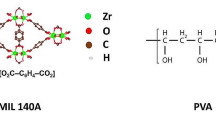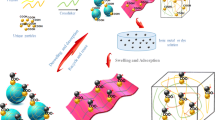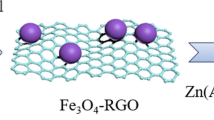Abstract
Natural gas can be sweetened by removing acidic gases with aqueous methyldiethanolamine (MDEA) solvents. Heavy metal ions and total organic acid anions (TOA) contaminate the industrial lean MDEA during this process. Continuous accumulation of these impurities creates operational problems, such as corrosion, fouling, and foaming of the operational unit. In this study, a series of interpenetrating network (IPN) nanocomposite hydrogels based on sodium alginate and acrylamide were successfully synthesized in the presence of fillers, such as silica (Alg-Aam-SiO2), polyaniline-coated silica (Alg-Aam-PA-SiO2), graphene oxide (Alg-Aam-GO), and thermally reduced graphene oxide (Alg-Aam-TRGO). The synthesized IPN hydrogels were applied for the adsorption of TOA and heavy metals (chromium and iron) simultaneously from lean MDEA. Different characterization techniques, such as FTIR, Raman, TGA, XRD, SEM, TEM, and equilibrium swelling studies, were performed to understand the superiority of the hydrogels. The maximum monolayer adsorption capacity of TOA anions at 53 °C was 21.45 mg/g for Alg-Aam, 23.47 mg/g for Alg-Aam-SiO2, 20.16 mg/g for Alg-Aam-PA-SiO2, 19.19 mg/g for Alg-Aam-TRGO, and 15.29 mg/g for Alg-Aam-GO. Thermodynamically, the adsorption of all contaminants was favorable, spontaneous, and endothermic. The produced Alg-Aam-based nanocomposite hydrogels are a great candidate for purifying the contaminated lean MDEA solvents.










Similar content being viewed by others
References
Farahbod F (2019) Investigation of gas sweetening by nanofluid in isothermal tower with consideration of thermodynamic equilibrium; experimentally and theoretically. Sep Purif Technol 21:799–808. https://doi.org/10.1016/j.seppur.2018.10.050
Momeni M, ElyasiKojabad B, Khanmohammadi S, Farshadi Z, Ghalandarzadeh R, Babaluo A, Zare M (2019) Impact of support on the fabrication of poly (ether-b-amid) composite membrane and economic evaluation for natural gas sweetening. J Nat Gas Sci Eng 62:236–246. https://doi.org/10.1016/j.jngse.2018.12.014
Maddox RN (1985) Gas conditioning and processing: gas and liquid sweetening. Campbell petroleum series, Oklahama
Manteghian M, Haddad J (2018) Reduction of chloride in amine from gas sweetening unit using a continuous virtual counter current ion exchange setup. J Nat Gas Sci Eng 56:568–578. https://doi.org/10.1016/j.jngse.2018.06.022
Verma N, Verma A (2009) Amine system problems arising from heat stable salts and solutions to improve system performance. Fuel Process Technol 90:483–489. https://doi.org/10.1016/j.fuproc.2009.02.002
Gao J, Wang S, Sun C, Zhao B, Chen C (2012) Corrosion behavior of carbon steel at typical positions of an amine-based CO2 capture pilot plant. Ind Eng Chem Res 51:6714–6721. https://doi.org/10.1021/ie203045v
Singh SL, Veerakumar U, Abbas A (2016) Control of contaminates & degradation products in amines during sour gas treatment. Abu Dhabi international petroleum exhibition and conference, Society of Petroleum Engineers, Abu Dhabi. https://doi.org/10.2118/182984-MS
Bayati B, Mirshekari M, Veisy A, Gando-Ferreira LM (2018) Removal of HSS from industrial amine solution by anionic resin (case study: ilam gas refinery). Chem Pap 73:491–500. https://doi.org/10.1007/s11696-018-0598-0
Abdi MA, Meisen A (1999) A novel process for diethanolamine recovery from partially degraded solutions. 1. process description and phase equilibria of the DEA-BHEP-THEED-Hexadecane system. Ind Eng Chem Res 38:3096–3104. https://doi.org/10.1021/ie980454t
Abdi MA, Meisen A (1999) A novel process for diethanolamine recovery from partially degraded solutions. 2 Process analysis. Ind Eng Chem Res 38:3105–3114. https://doi.org/10.1021/ie9804531
Tavan Y, Moradi M, Rostami A, Azizpour H (2020) Theoretical and industrial aspects of amine reclaiming unit to separate heat stable salts. Sep Purif Technol 237:116314. https://doi.org/10.1016/j.seppur.2019.116314
Pal P, Banat F, AlShoaibi A (2013) Adsorptive removal of heat stable salt anions from industrial lean amine solvent using anion exchange resins from gas sweetening unit. J Nat Gas Sci Tech 15:14–21. https://doi.org/10.1016/j.jngse.2013.08.001
Pal P, Banat F (2013) Comparison of heavy metal ions removal from industrial lean amine solvent using ion exchange resins and sand coated with chitosan. J Nat Gas Sci Technol 18:227–236. https://doi.org/10.1016/j.jngse.2014.02.015
Pal P, Banat F (2015) Removal of contaminants from industrial lean amine solvent using polyacrylamide hydrogels optimized by response surface methodology. Adsorp Sci Technol 33:9–24. https://doi.org/10.1260/0263-6174.33.1.9
Pal P, Edathil AA, Banat F (2019) Calcium alginate gel and hard beads for the removal of total organic acid anions and heavy metal ions from industrial lean methyldiethanolamine solvent. Poly Bull 76:103–118. https://doi.org/10.1007/s00289-018-2376-0
Edathil AA, Alhseinat E, Banat F (2019) Removal of heat stable salts from industrial lean methyldiethanolamine using magnetic alginate/iron oxide hydrogel composite. Int J Greenh Gas Control 83:117–127. https://doi.org/10.1016/j.ijggc.2019.02.005
Edathil AA, Pal P, Banat F (2018) Alginate clay hybrid composite adsorbents for the reclamation of industrial lean methyldiethanolamine solutions. Appl Clay Sci 156:213–223. https://doi.org/10.1016/j.clay.2018.02.015
Edathil AA, Pal P, Kannan P, Banat F (2020) Total organic acid adsorption using alginate/clay hybrid composite for industrial lean amine reclamation using fixed-bed: parametric study coupled with foaming. Int J Greenh Gas Control 94:102907. https://doi.org/10.1016/j.ijggc.2019.102907
Ma J, Zhou G, Chu L, Liu Y, Liu C, Luo S, Wei Y (2017) Efficient removal of heavy metal ions with an EDTA functionalized chitosan/polyacrylamide double network hydrogel. ACS Sustain Chem Eng 5:843–851. https://doi.org/10.1021/acssuschemeng.6b02181
Guoqing X, Fangzhou L, Yuanyuan L, Chunyan C, Chunlin C, Qian L, Wanxin C (2022) A novel biomass material composite hydrogel based on sodium alginate. Colloids Surf A Physicochem Eng Asp 648:129383. https://doi.org/10.1016/j.colsurfa.2022.129383
Yoshimi S, Hideaki T (2022) Hydrogel adsorbents for the removal of hazardous pollutants—requirements and available functions as adsorbent. Gels 8(4):220. https://doi.org/10.3390/gels8040220
Zenab D, Syed S, Rama G, Irfan A, Nanthini S (2022) Hydrogel-based adsorbent material for the effective removal of heavy metals from wastewater: a comprehensive review. Gels 8(5):263. https://doi.org/10.3390/gels8050263
Bahrami Z, Akbari A, Eftekhari-Sis B (2019) Double network hydrogel of sodium alginate/polyacrylamide cross-linked with POSS: swelling, dye removal and mechanical properties. Int J Biol Macromol 129:187–197. https://doi.org/10.1016/j.ijbiomac.2019.02.046
Olad A, Zebhi H, Salari D, Mirmohseni A, Reyhanitabar A (2018) A promising porous polymer-nanoclay hydrogel nanocomposite as water reservoir material: synthesis and kinetic study. J Porous Mater 25:665–675. https://doi.org/10.1007/s10934-017-0479-x
Oladipo AA, Gazi M (2015) Microwaves initiated synthesis of activated carbon-based composite hydrogel for simultaneous removal of copper(II) ions and direct red 80 dye: a multi-component adsorption system. J Taiwan Inst Chem Eng 47:125–136. https://doi.org/10.1016/j.jtice.2014.09.027
He J, Jin J, Wang Z, Yin H, Wei C, Xu X (2018) Encapsulating nanosilica into polyacrylic acid and chitosan interpenetrating network hydrogel for preconcentration of uranium from aqueous solutions. J Radio Nucl Chem 317:1299–1309. https://doi.org/10.1007/s10967-018-6034-7
MahmoudFekry MENA, El-Latif MMA (2016) Nanocomposites of nanosilica-immobilized-nanopolyaniline and cross-linked nanopolyaniline for removal of heavy metals. Chem Eng J 304:679–691. https://doi.org/10.1016/j.cej.2016.06.11
Hayati B, Maleki A, Najafi F, Gharibi F, Mckay G, Gupta VK, Marzban N (2018) Heavy metal adsorption using PAMAM/CNT nanocomposite from aqueous solution in batch and continuous fixed bed systems. Chem Eng J 346:258–270. https://doi.org/10.1016/j.cej.2018.03.172
Fan J, Shi Z, Lian M, Li H, Yin J (2013) Mechanically strong graphene oxide/sodium alginate/polyacrylamide nanocomposite hydrogel with improved dye adsorption capacity. J Mater Chem A 1:7433–7443. https://doi.org/10.1039/C3TA10639J
Li J, Gunister E, Barsoum I (2019) Effect of graphene oxide as a filler material on the mechanical properties of LLDPE nanocomposites. J Compos Mat 53:2761–2773. https://doi.org/10.1177/0021998319839215
Pei H, Wufeng C, Lifeng Y (2013) An inorganic-organic double network hydrogel of graphene and polymer. Nanoscale 5:6034–6039. https://doi.org/10.1039/C3NR00214D
Wang J, Zheng S, Shao Y, Liu J, Xu Z, Zhu D (2010) Amino-functionalized Fe3O4@SiO2 core-shell magnetic nanomaterial as a novel adsorbent for aqueous heavy metals removal. J Colloid Interface Sci 349:293–299. https://doi.org/10.1016/j.jcis.2010.05.010
Pourjavadi A, Tehrani ZM, Salimi H, Banazadeh A, Abedini N (2015) Hydrogel nanocomposite based on chitosan-g-acrylic acid and modified nanosilica with high adsorption capacity for heavy metal ion removal. Iran Polym J 24:725–734. https://doi.org/10.1007/s13726-015-0360-1
Saadia L, Imane M, Abdelkader EK, Lilia S, M’hamed K, Abdelghani B (2022) Application of activated carbon adsorbents prepared from prickly pear fruit seeds and a conductive polymer matrix to remove congo red from aqueous solutions. Fibers 10(1):7. https://doi.org/10.3390/fib10010007
Daikh S, Ouis D, Benyouce A, Mouffok B (2022) Equilibrium, kinetic and thermodynamic studies for evaluation of adsorption capascity of a new potential hybrid adsorbent based on polyaniline and chitosan for Acetaminophen. Chem Phys Lett 798:139565. https://doi.org/10.1016/j.cplett.2022.139565
Ali N, Pal P, Banat F, Srinivasakannan C (2019) Selective removal of diethanolamine from methyldiethanolamine solution using chemically reduced single-layer graphene and activated carbon. Sep Sci Technol 54:2671–2681. https://doi.org/10.1080/01496395.2018.1549569
Sitko R, Turek E, Zawisza B, Malicka E, Talik E, Heimann J, Gagor A, Feista B, Wrzalik R (2013) Adsorption of divalent metal ions from aqueous solutions using graphene oxide. Dalton Trans 42:5682–5689. https://doi.org/10.1039/c3dt33097d
Langmuir I (1918) The adsorption of gases on plane surface of glass, mica and platinum. J Am Chem Soc 40:1361–1403. https://doi.org/10.1021/ja02242a004
Freundlich HM (1906) Over the adsorption in solution. J Phys Chem 57:385–470
Tran HN, You S, Chao H (2016) Thermodynamic parameters of cadmium adsorption onto orange peel calculated from various methods: a comparison study. J Environ Chem Eng 4:2671–2682. https://doi.org/10.1016/j.jece.2016.05.009
Elanthamilan E, Sathiyan A, Rajkumar S, Sheryl EJ, Merlin JP (2018) Polyaniline based charcoal/Ni nanocomposite material for high performance supercapacitors. Sustain Energy Fuels 2:811–819. https://doi.org/10.1039/C7SE00490G
Angela K, Jozef H, Vlasta S, Milan P, Vladimír Š, Juraj P (2015) FTIR spectroscopy of silicon carbide thin films prepared by PECVD technology for solar cell application. Proc SPIE. https://doi.org/10.1117/122186748
Alves TVG, Tavares EJM, Aouada FA, Negrão CAB, Oliveira MEC, Júnior APD, da Costa CEF, Júnior JOCS, Costa RMR (2011) Thermal analysis characterization of PAAm-co-MC hydrogels. J Therm Anal Calorim 106:717–724. https://doi.org/10.1007/s10973-011-1572-z
Gautam V, Srivastava A, Singh KP, Yadav VL (2017) Preparation and characterization of polyaniline, multiwall carbon nanotubes, and starch bionanocomposite material for potential bioanalytical applications. Polym Compos 38:496–506. https://doi.org/10.1002/pc.23608
Iqbal MZ, Pal P, Shoaib M, Abdala AA (2017) Efficient removal of different basic dyes using graphene. Desalin Water Treat 68:226–235. https://doi.org/10.5004/dwt.2017.20213
Cheng Y, Luo X, Betz J, Payne GF, Bentley WE, Rubloff GW (2011) Mechanism of anodic electrodeposition of calcium alginate. Soft Mat 7:5677–5684. https://doi.org/10.1039/C1SM05210A
Jonathan N (1961) The infrared and Raman spectra and structure of acrylamide. J Mol Spec 6:205–214. https://doi.org/10.1016/0022-2852(61)90243-0
Biswas RK, Khan P, Mukherjee S, Mukhopadhyay AK, Ghosh J, Muraleedharan K (2018) Study of short range structure of amorphous silica from PDF using Ag radiation in laboratory XRD system, RAMAN and NEXAFS. J Non-Cryst Solids 488:1–9. https://doi.org/10.1016/j.jnoncrysol.2018.02.037
Wang R, Han M, Zhao Q, Ren Z, Guo X, Hu CN, Lu L (2017) Hydrothermal synthesis of nanostructured graphene/polyaniline composites as high-capacitance electrode materials for supercapacitors. Sci Rep 7:44562. https://doi.org/10.1038/srep44562
Jianfeng S, Bo Y, Tie L, Yu L, Na L, Mingxin Y (2012) Study on graphene-oxide-based polyacrylamide composite hydrogels. Compos Part A Appl Sci Manuf 43:1476–1481. https://doi.org/10.1016/j.compositesa.2012.04.006
Oh T, Choi CK (2010) Comparison between SiOC thin film by plasma enhance chemical vapor deposition and SiO2 thin film by Fourier transform infrared spectroscopy. J Korean Phys Soc 56:1150–1155. https://doi.org/10.3938/jkps.56.1150
Samanta HS, Ray SK (2014) Synthesis, characterization, swelling and drug release behavior of semi-interpenetrating network hydrogels of sodium alginate and polyacrylamide. Carbohydr Polym 99:666–678. https://doi.org/10.1016/j.carbpol.2013.09.004
Karlowatz M, Aleksandrov A, Orlando T, Cathcart JM, Mizaikoff B (2004) The influence of wetting and drying cycles on mid-infrared attenuated total-reflection spectra of quartz: understanding spectroscopy of disturbed soil. Proc SPIE. https://doi.org/10.1117/12542898
Hussein A, Sarkar S, Kim B (2016) Low temperature reduction of graphene oxide using hot-plate for nanocomposites applications. J Mat Sci Tech 32:411–418. https://doi.org/10.1016/j.jmst.2016.02.001
Shehab AM, Abdelbary ESM, Elsherbiny IM, Butler IS, Mostafa SI (2019) Efficient adsorption of Cd (II) ions from aqueous media onto a semi-interpenetrating bio-composite. Environ Prog Sustain Energy 38:e13253. https://doi.org/10.1002/ep.13253
Kamata H, Akagi Y, Kayasuga-Kariya Y, Chung U, Sakai T (2014) “Nonswellable” hydrogel without mechanical hysteresis. Science 343:873–875. https://doi.org/10.1126/science.1247811
Lim LS, Rosli NA, Ahmad I, Lazim AM, Amin MCIM (2017) Synthesis and swelling behavior of pH-sensitive semi-IPN superabsorbent hydrogels based on poly(acrylic acid) reinforced with cellulose nanocrystals. Nanomaterials 7:399. https://doi.org/10.3390/nano7110399
Sun JY, Zhao X, Illeperuma WRK, Chaudhuri O, Oh KH, Mooney DJ, Vlassak JJ, Suo Z (2012) Highly stretchable and tough hydrogels. Nature 489:133–136. https://doi.org/10.1038/nature11409
Coradin T, Nassif N, Livage J (2003) Silica–alginate composites for microencapsulation. App Microbio Biotech 61:429–434. https://doi.org/10.1007/s00253-003-1308-5
Jia Y, Chen J, Liu W, Yin D (2019) Construction of highly stretchable silica/polyacrylamide nanocomposite hydrogels through hydrogen bond strategy. J Poly Res 26(119):1–9. https://doi.org/10.1007/s10965-019-1761-1
Godiya CB, Cheng X, Li D, Chen Z, Lu X (2019) Carboxymethyl cellulose/polyacrylamide composite hydrogel for cascaded treatment/reuse of heavy metal ions in wastewater. J Hazard Mater 364:28–38. https://doi.org/10.1016/j.jhazmat.2018.09.076
Acknowledgements
The authors are grateful to Khalifa University Gas Processing and Materials Science Research Center, Abu Dhabi, for funding the project (GRC11006).
Author information
Authors and Affiliations
Corresponding authors
Ethics declarations
Conflict of interest
The authors have no conflicts of interest to declare that are relevant to the content of this article.
Human or animal rights
Also, the authors have not used any animal studies or human participants' involvement in this study.
Additional information
Publisher's Note
Springer Nature remains neutral with regard to jurisdictional claims in published maps and institutional affiliations.
Supplementary Information
Below is the link to the electronic supplementary material.
Rights and permissions
Springer Nature or its licensor (e.g. a society or other partner) holds exclusive rights to this article under a publishing agreement with the author(s) or other rightsholder(s); author self-archiving of the accepted manuscript version of this article is solely governed by the terms of such publishing agreement and applicable law.
About this article
Cite this article
Edathil, A.A., Othman, I., Pal, P. et al. Interpenetrating network nanocomposite hydrogels as efficient adsorbents for the removal of total impurities from industrial lean methyldiethanolamine solution. Polym. Bull. 80, 9913–9939 (2023). https://doi.org/10.1007/s00289-022-04542-2
Received:
Revised:
Accepted:
Published:
Issue Date:
DOI: https://doi.org/10.1007/s00289-022-04542-2




